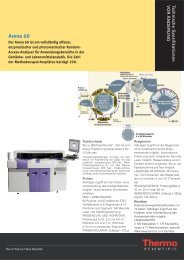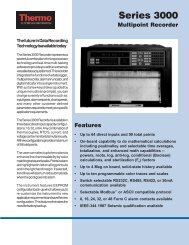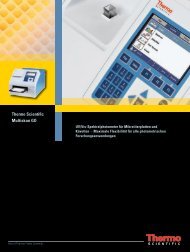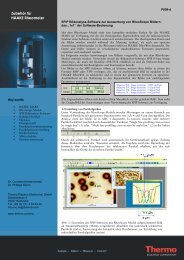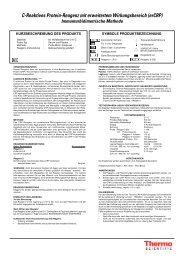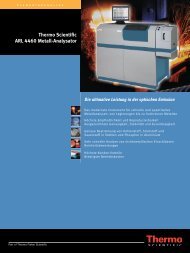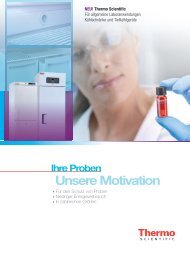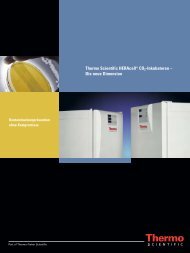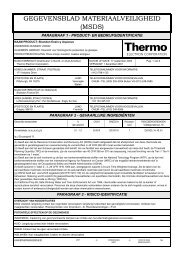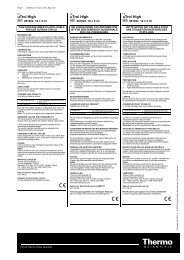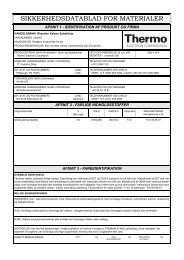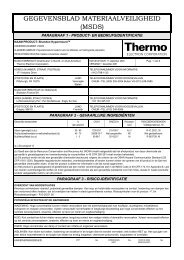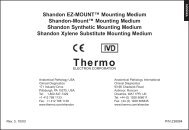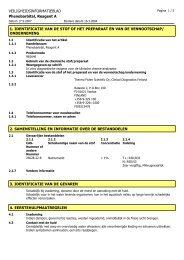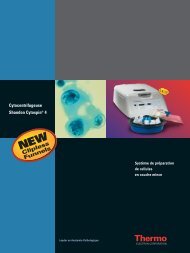Orion 2117HL High Level Chloride Analyzer User Guide
Orion 2117HL High Level Chloride Analyzer User Guide
Orion 2117HL High Level Chloride Analyzer User Guide
Create successful ePaper yourself
Turn your PDF publications into a flip-book with our unique Google optimized e-Paper software.
General Information<br />
Principles of<br />
Calibration<br />
Double Known<br />
Addition (DKA)<br />
Figure I-2<br />
Flow Cell Volume for DKA<br />
Thermo Scientific <strong>Orion</strong> <strong>2117HL</strong> <strong>High</strong> <strong>Level</strong> <strong>Chloride</strong> <strong>Analyzer</strong> <strong>User</strong> <strong>Guide</strong><br />
Calibration procedures for analytical instruments are important and must<br />
be performed carefully. The calibration procedure used in the Thermo<br />
Scientific <strong>Orion</strong> <strong>2117HL</strong> analyzer is a variation of Double Known<br />
Addition (DKA) using advanced electrode and flow cell technology. This<br />
method has the distinct advantages of being fast, easy and accurate.<br />
Before calibration begins, the diverter valve is pushed in to divert flow from<br />
the measure drain, allowing the flow cell to fill.<br />
At the beginning of the DKA calibration the actual concentration in the<br />
sample is unknown. The analyzer measures the potential (Es) and stores<br />
this value in the microprocessor. A known amount of standard 1 solution<br />
is added to the flow cell, which increases the concentration (Cs) with a<br />
corresponding known amount (dC1). During this process, air is pumped<br />
into the flow cell, thoroughly mixing sample and standard in a closedloop<br />
system. The new potential (E1) is measured and stored automatically<br />
when stability is reached. Adding standard 2, preferably 10 times more<br />
concentrated than standard 1, increases the concentration (dC2) in the<br />
sample reservoir. Again, the new potential (E2) is measured and stored<br />
when the reading is stable. Now, we have the following three unknowns:<br />
Es =Eo + S(Ts/298.15) log (Cs/Ciso)<br />
E1 =Eo + S(T1/298.15) log [(Cs + dC1)/Ciso]<br />
E2 =Eo + S(T2/298.15) log [(Cs+ dC1+ dC2)/Ciso]<br />
S is the Slope at 25 °C (298.15 K)<br />
T is the temperature in Kelvin, measured when the potential E is measured.<br />
Es, E1, E2 have been determined during the calibration procedure. The<br />
microprocessor solves these three equations, to obtain the values of S<br />
and Eo. The calibration result is stored for use during online monitoring<br />
to convert the measured potential and temperature in the sample into<br />
concentration values in either ppm or ppb.<br />
When the calibration is complete the flow cell drains as the sample flow<br />
returns. The flow cell volume returns to the measurement level. After<br />
allowing approximately 30 minutes for concentrated calibration solution<br />
to be flushed from the system, the <strong>2117HL</strong> analyzer can begin sample<br />
measurement again.<br />
In addition to Double Known Addition (DKA), the <strong>2117HL</strong> analyzer also<br />
allows the operator the ability to perform an offline calibration.<br />
I-5



